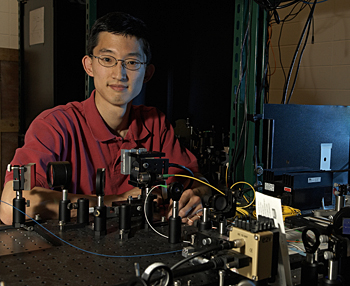The award, which is highly competitive, is bestowed on those scientists deemed most likely to become the academic leaders of the 21st century. Five UD assistant professors have received the honor so far in 2008, and three are from the Department of Electrical and Computer Engineering.
“The NSF Career Award was a very, very pleasant surprise,” Buma said. “I am quite humbled, in fact. This has been an amazing year for the University of Delaware, and for our department.”
The five-year, $399,999 grant will support Buma's research and education program on ultrasound biomicroscopy, a high-resolution imaging technique with potential biomedical applications in dermatology and ophthalmology.
Buma said that ultrasound biomicroscopy produces exquisite images of tissue microstructure but has failed to make the leap to widespread clinical use. A major technical obstacle has been the lack of suitable sensor arrays operating at high ultrasonic frequencies.
“To be able to image smaller features requires ultrasound wavelengths that are smaller,” Buma said. “That in turn requires smaller ultrasound transmitters and receiver arrays.”
Buma said conventional engineering methods have not been successful in developing miniaturized arrays. His research is in optoacoustic technology, which he said could potentially revolutionize the imaging performance of ultrasound biomicroscopy systems.
Optoacoustics involves the use of light to detect ultrasound. “The wavelength of light is so small, you can focus to a very small spot,” Buma said. “If you can detect ultrasound from that small spot, you can exploit the high resolution properties of light to create an array.”
Optical techniques for ultrasound detection can produce broadband, large aperture and highly populated sensor arrays unattainable with conventional ultrasound technology, he said.
Buma's goals are to develop optoacoustic sensor arrays for high-speed data acquisition and to develop optoacoustic-based array scanners for real-time imaging. Ultimately, he said the future of ultrasound biomicroscopy would provide for three-dimensional visualization.
Buma said development of optoacoustic sensor arrays would fill a void in medical imaging. Optical microscopy can image the skin's surface, while conventional ultrasound can image deeper into the body, the latter familiar to anyone who has been expecting a baby. The new arrays would provide high-resolution images within about 5 millimeters of the skin surface.
Clinical applications include dermatology, where it could be used to detect skin diseases and cancers, and ophthalmology, where it could be used to determine the health of the cornea and particularly the iris. Ultrasound biomicroscopy also can be used in imaging small animals, such as laboratory mice, for developmental biology research.
In addition to research, NSF Career Awards have strong education and outreach components and Buma said he plans to include graduate, undergraduate and even high school students in the work. He teaches a medical imaging course and hopes to develop distance learning and distance laboratory components to broaden instruction in the principles of bioimaging.
Buma received a bachelor's degree in electrical engineering and a certificate in engineering physics from Princeton University and a master's degree in electrical engineering and doctorate in applied physics from the University of Michigan, where he was a postdoctoral research fellow at the Center for Ultrafast Optical Science. He joined the UD faculty in 2005.
Article by Neil Thomas
Photo by Kathy Atkinson


